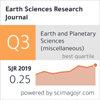Coffee plantation soil characterization using a multi-method approach near the Volcano Nevado del Ruiz, Colombian Central Cordillera
IF 0.7
4区 地球科学
Q4 GEOSCIENCES, MULTIDISCIPLINARY
引用次数: 1
Abstract
The presence of iron oxides may provide a sensitive indicator of the effects of cropping practices on coffee plantations. Authors characterized the mineral phases present in soil A horizons at three different farms located in the Department of Tolima within the regions of Líbano and Villahermosa. Our analysis includes X-ray diffraction, Mössbauer spectroscopy, and remote sensing to discriminate the distribution of the different magnetic mineral phases. X-ray diffraction was used to identify the mineralogical properties of iron oxide such as hematite, goethite, and ferrihydrite (Fh), as well as tectosilicate minerals such as albite and sanidine. Mössbauer spectroscopy results for samples taken at room temperature indicate the presence of Fe2+ and Fe3+ mineral phases, which possibly correspond to ilmenite or magnetite. Finally, Sentinel-2A multi-spectral imager (MSI) data was used to map the distribution of iron oxides and study the influence of their distribution throughout the study area. A high correlation between Mössbauer spectroscopy and Sentinel-2A MSI data exists throughout the study area. The results suggest that farms close to the main Nevado del Ruíz Volcano have a more significant mineralogical variability. In contrast, more distant farms are characterized by soils with more iron oxides, the product of weathering, erosion, and human activities.哥伦比亚中科迪勒拉Nevado del Ruiz火山附近咖啡种植园土壤的多方法表征
氧化铁的存在可能为种植做法对咖啡种植园的影响提供一个敏感的指标。作者对位于利巴诺和维拉赫莫萨地区托利马省的三个不同农场的土壤A层中存在的矿物相进行了表征。我们的分析包括X射线衍射、穆斯堡尔谱和遥感,以区分不同磁性矿物相的分布。X射线衍射用于鉴定氧化铁的矿物学性质,如赤铁矿、针铁矿和水铁矿(Fh),以及盖层硅酸盐矿物,如钠长石和三苯胺。在室温下采集的样品的穆斯堡尔谱结果表明存在Fe2+和Fe3+矿物相,它们可能对应于钛铁矿或磁铁矿。最后,Sentinel-2A多光谱成像仪(MSI)数据用于绘制氧化铁的分布图,并研究其在整个研究区域的分布影响。Mössbauer光谱和Sentinel-2A MSI数据之间存在高度相关性。研究结果表明,靠近鲁伊斯火山的农场具有更显著的矿物学变异性。相比之下,更远的农场的特点是土壤中含有更多的铁氧化物,这是风化、侵蚀和人类活动的产物。
本文章由计算机程序翻译,如有差异,请以英文原文为准。
求助全文
约1分钟内获得全文
求助全文
来源期刊

Earth Sciences Research Journal
地学-地球科学综合
CiteScore
1.50
自引率
0.00%
发文量
0
审稿时长
>12 weeks
期刊介绍:
ESRJ publishes the results from technical and scientific research on various disciplines of Earth Sciences and its interactions with several engineering applications.
Works will only be considered if not previously published anywhere else. Manuscripts must contain information derived from scientific research projects or technical developments. The ideas expressed by publishing in ESRJ are the sole responsibility of the authors.
We gladly consider manuscripts in the following subject areas:
-Geophysics: Seismology, Seismic Prospecting, Gravimetric, Magnetic and Electrical methods.
-Geology: Volcanology, Tectonics, Neotectonics, Geomorphology, Geochemistry, Geothermal Energy, ---Glaciology, Ore Geology, Environmental Geology, Geological Hazards.
-Geodesy: Geodynamics, GPS measurements applied to geological and geophysical problems.
-Basic Sciences and Computer Science applied to Geology and Geophysics.
-Meteorology and Atmospheric Sciences.
-Oceanography.
-Planetary Sciences.
-Engineering: Earthquake Engineering and Seismology Engineering, Geological Engineering, Geotechnics.
 求助内容:
求助内容: 应助结果提醒方式:
应助结果提醒方式:


